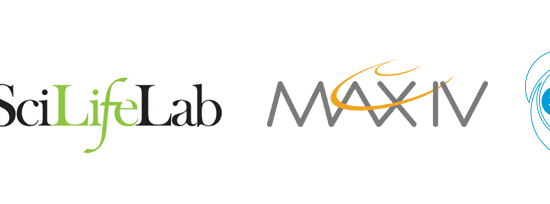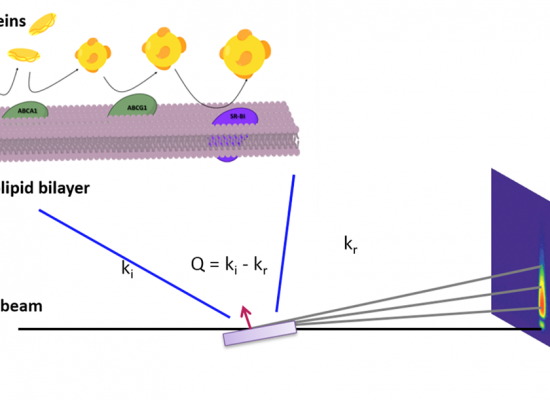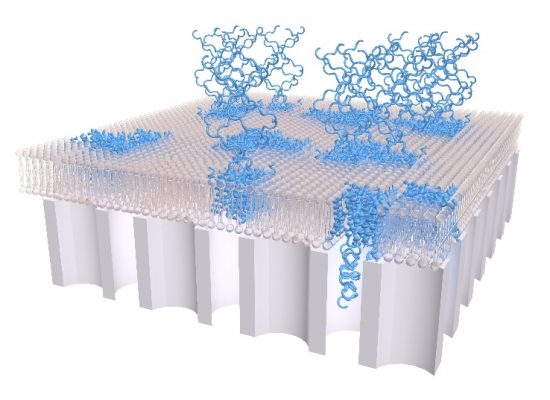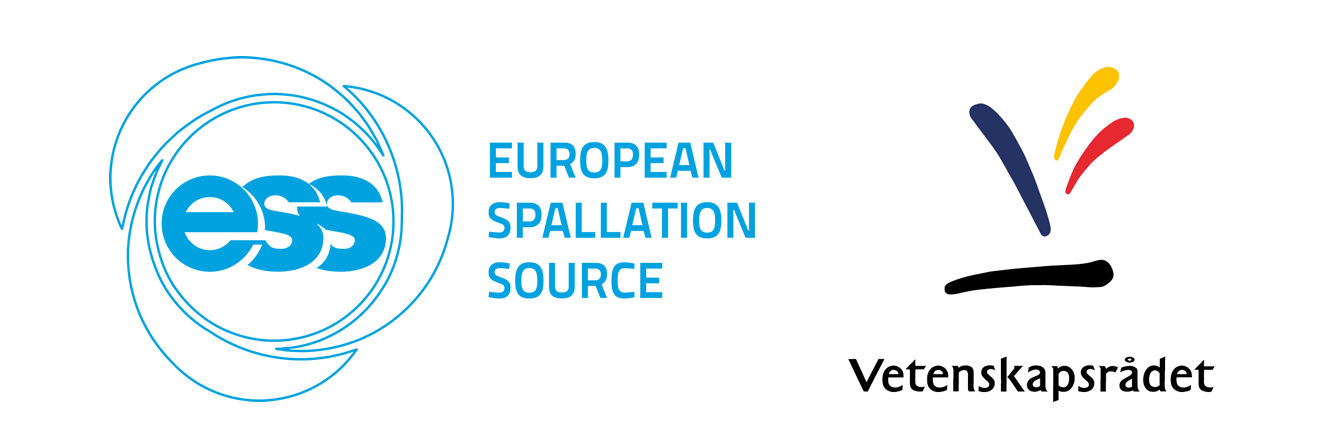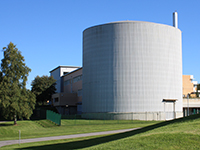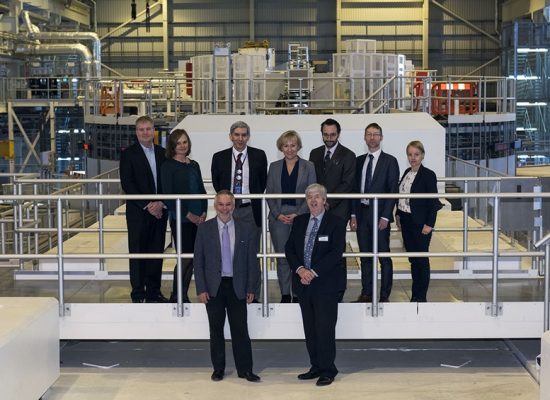Tim is a PhD at the Materials Physics divisions of Uppsala University. He works in the Soft Matter group on time- and interface dependent ordering processes of soft crystals. His project can help with understanding how the microstructure of polymer micellar systems is affected by interfaces and mechanical strain. As a next step these effects […]
Student’s Spotlight – Frank Elson
Frank is a third-year PhD student from KTH, Applied Physics, working in the SMaRT group on low dimensional quantum materials, such as superconductors and quantum magnets. His project can help in further understanding the phases of many body quantum systems, which could in term aid in furthering material-based solutions to be used in new technologies […]
Call for collaborative Sweden-ILL PhD projects
As part of the Scientific Member agreement between Sweden and the Institut Laue Langevin (ILL) for the period 2024 – 2029, 4 four-year PhD projects are available to be filled as soon as possible. These projects are intended to strengthen the Swedish neutron scattering community in all regions and across a range of scientific areas […]
MATRAC 2 school in Germany
The MATRAC 2 School will provide a systematic overview of the application of neutrons and synchrotron radiation to the structural analysis of engineering materials and will focus on neutron scattering and imaging experiments. Students and young scientists from research and industry from all over Europe interested in this field are welcome to participate. This school […]
List of Upcoming Events Surrounding Neutron Scattering
Within Sweden Northern Lights on Food Conference: Boosting structural food science, Lund – 27-29 May 2024 Swedish Neutron Week, Lund – 29-31 May 2024 Outside Sweden QENS/WINS 2024, Manchester (UK) – 10-14 June 2024 SXNS17, 17th International Conference on Surface X-ray and Neutron Scattering, Grenoble (France) – 15-18 July 2024 MATRAC 2 school, Neutrons […]
Student’s Spotlight – Yuqing Ge
Yuqing is a PhD student from KTH studying quantum materials such as 2 dimensional (2D) materials. There, the “2D” includes not only thin films, but also quasi low-dimensional materials which are bulk material by themselves but are treated as 2D, considering their low coupling between the natural plane in nuclear structures. For example, the van […]
Improved polarizing neutron optics with increased reflectivity, enhanced polarization, less diffuse scattering and eliminated magnetic coercivity
by Anton Zubayer Neutron optics are essential parts of neutron scattering facilities, where they guide, collimate, focus, and polarize the neutron beam tailored to each beamlines experiments. The most common neutron optics are multilayer neutron optics which are characterized by alternating layers of materials. For polarizing neutron optics, one of the layers must be magnetic […]
Swedish Neutron Week 2024 to be held in May
We are pleased to announce that the Swedish Neutron Week 2024 will be organized in Lund, with Lund University and ESS as local organizers. The conference will be held at Stadshallen 29th – 31st May 2024. The event is jointly arranged by SNSS, SwedNess, ESS and Lund University, and is open to everyone who is, or wish to be, part of the Swedish neutron scattering […]
Student’s Spotlight – Ratchawit (Leo) Janewithayapun
Leo is a PhD student at Chalmers University working on the characterization and synthesis of melt-processable materials derived from wheat bran. Polysaccharides, such as cellulose or xylan are not melt-processable in their native state. However, with chemical modification, these abundant natural polymers can be transformed into materials exhibiting plastic-like processability and mechanical properties. In his […]
Student’s Spotlight – Karthika Kariattukarakaran Thilakan
Karthika is a PhD student from Uppsala University, working on the structure-property relationship in magnetic materials. Her primary focus involves working with metallic alloys, specifically magnetic quasicrystal approximants. Her research project consists of two main parts: the first delves into complex magnetic structures, with a focus on understanding non-trivial magnetic ground states and identifying universal […]
Swedish Neutron Week 2024 – save the date
29 – 31 May 2024, Lund We are happy to anounce that the Swedish Neutron Week in 2024 will take place in Lund between 29-31 May from lunch-to-lunch. In the afternoon of the 31st, a visit of the ESS site is planned to enable the community some first-hand impressions about the progress at the facility. On the Monday and […]
The Onset of Molecule-Spanning Dynamics in Heat Shock Protein Hsp90
by Felix Roosen-Runge Proteins are the biomacromolecular motors of life. While earlier accounts stressed the lock-key concept of protein function, a more complete understanding needs to take into account motions and molecular flexibility as ingredients how specific functions can be performed. In particular, larger conformational changes are known to reflect allosteric changes from active to […]
Student’s Spotlight – Juanita Francis
Juanita is a third-year PhD student from Lund University, focused on understanding the formation of silk model systems—specifically, recombinant Cylindriform silk and reconstituted silkworm silk. Her project will help in developing new design rules for mediating protein self-assembly by examining the aqueous polymer processing exhibited by cylindriform silk proteins. The transfer of this technology could […]
Interaction of a Histidine-Rich Antimicrobial Saliva Peptide with Model Cell Membranes: The Role of Histidines
by Amanda Eriksson Skog, Yuri Gerelli and Marie Skepö Here we present a continuation study of our previous paper, Spontaneous Formation of Cushioned Model Membranes Promoted by an Intrinsically Disordered Protein, in which we found that upon the interaction of Histatin 5 (Hst5) with a model lipid bilayer, a peptide cushion spontaneously forms underneath the […]
ESS – in-kind projects
The purpose of the projects funded by the Research council is to enable Swedish researchers to contribute to the build-up of the European Spallation Source (ESS) and for Swedish competence within areas such as instrumentation to be built up and new collaborations developed. In-kind collaborations provide a close link to ESS, one of the world’s […]
A Comprehensive Experimental Approach to Multifunctional Quantum Materials & their Physical Properties – Geometry and Physics in Condensed Matter
by Elisabetta Nocerino Symmetry-breaking phenomena underpin various intriguing physical properties in condensed matter such as magnetism [1,2,3,4] and superconductivity [5,6]. Understanding such fundamental properties holds significant importance for the development of cutting-edge technologies, including spintronics, quantum computing, and advanced magnetic materials, as well as foster innovation in energy-related applications [7]. The crystalline solid NaCr2O4 represents […]
A guide to spatially resolved phase and texture evaluation by diffraction contrast neutron imaging
The physical properties of structural as well as functional components are largely governed by the materials microstructure. In polycrystalline materials, the crystallographic phase and preferred grain orientation (texture) can dominate the physical properties. A range of microscopy and diffraction techniques are hence routinely used for their characterization, but are prone to miss local variations across […]
Coexisting curved and flat membranes
The complexity of cellular membranes is not only reflected by their wide molecular composition but also in the wide range of morphologies with coexisting high and low curvature regions. Very little is known about the nanostructure of curved membranes, due to limitations in experimental and simulation approaches. Even though curvature-induced microscopic phase separation has been […]
Webinar Registration: Structure Generation for MD Simulations of Soft Matter Systems
It is our great pleasure to invite you to an online launch event and workshop to showcase two new software workflows which will be of interest to the Small-angle Scattering and Disordered Materials communities. The development of these tools has been funded by the Ada Lovelace Centre and they are intended to offer users new […]
Advancements in Thermal Neutron Scattering Law Generation
The design of neutron systems, for example nuclear reactors and neutron sources, requires the usage of Monte-Carlo simulation software to predict the distributions of neutrons throughout the system. At low energies, the interactions of neutrons with a material is driven by interactions on the atomic and molecular scale and thus a proper description of this […]
Swedish in-kind to ESS
The Swedish neutron community have long been asking for a way of contributing in-kind to ESS, and now it is possible. This way, Sweden can build competence in instrumentation and new collaborations develop. In-kind collaborations can give a close connection to the ESS instrument projects and opportunities to be involved in first science at ESS.
Method to simultaneously probe the bulk modulus and structure of soft compressible objects using small-angle neutron scattering with contrast variation
An object’s bulk modulus quantifies its resistance to an isotropic compression. For soft deformable colloids the bulk modulus must be known to predict their response to crowding. Figure 1: (a) Sketch of the basic principle of our new method. Blue spheres represent the nanogels while the green lines are for the dPEG which, in neutrons, […]
Coupling lipid nanoparticle structure and automated single particle composition analysis to design phospholipase responsive nanocarriers
Lipid nanoparticles (LNPs) are currently under intense scrutiny for vaccine delivery and RNA therapies. Key to their successful optimisation and translation is a nanoscale, single particle characterisation of the relationship between LNP structure, composition, and performance. Maximising performance and understanding intracellular trafficking are key components of LNP rational design. Phospholipases, specific lipid modifying enzymes, are […]
Neutron reflection and deuteration reveal new insights about the interaction of DHODH enzymes with ubiquinone in mitochondrial model membranes
DHODH (dihydroorotate dehydrogenase) catalyzes a key step in the biosynthesis of pyrimidines, precursors of nucleic acids needed for DNA and RNA synthesis in all living organisms. Because of this, DHODH is a drug target for the inhibition of inflammation and investigated as a target to inhibit cell proliferation (cancer) and viral replication. Human DHODH is […]
Chiral spin liquid ground state in YBaCo3FeO7 observed by polarised diffuse neutron scattering
Spin liquids are a topical and fascinating subject of condensed matter physics, fueled by the hope to create novel ground-states of matter. Typically, the combination of antiferromagnetic interactions with strong frustration leads to a rich variety of highly correlated spin states rather than to conventional order. Experimental research, however, has remained inconclusive in respect to […]
New study indicates limited water circulation late in the history of Mars
Nakhlite meteorites are igneous rocks from Mars that reacted with water ~630 million years ago while still part of the Martian bedrock, during a time that is often suggested to have been a “dry” period on Mars. However, magmatism and meteorite impacts can trigger so called hydrothermal systems with warm fluids circulating in the bedrock, […]
Correlations between Precipitation Reactions and Electrochemical Performance of Lithium–Sulfur Batteries Studied by Operando Scattering Techniques
Li-S batteries are promoted as a highly promising energy storage solution, but the specific energy demonstrated so far (~400 W h kg‑1) is restricted by the low utilization of active materials in both lithium and sulfur electrodes. The incomplete discharge process of the sulfur electrode is associated with precipitation of insulating reaction products from polysulfide intermediates. This process, […]
Probing the solution structure of the pentameric ligand-gated ion channel GLIC by small-angle neutron scattering
Membrane proteins mediate communication between the outside and inside of cells, and are common drug targets. Detailed understanding of the structure and function of these proteins enrich our basic understanding of how biology works at a molecular level, and can in the long run inform drug development. We have focused on the pentameric ligand-gated ion […]
SARS-CoV-2 spike protein removes lipids from model membranes and interferes with the capacity of high-density lipoprotein to exchange lipids
The COVID 19 pandemic had worldwide impact in 2020 and continues to do so to this day. Understanding how the SARS-CoV-2 virus interacts with the body and why it has greater impact on some areas of the population than others is of great importance. Early on, studies found the need for the presence of cholesterol […]
GISANS studies using fan shaped beams
The understanding of interfacial properties of materials as well as interfacial processes in terms of structural, morphological and compositional changes is of crucial importance in many scientific fields that include chemistry, physics, biology and engineering. Overall, surface science has advanced enormously over the last decades, which is related to the development of a series of […]
Design of Lipid-Based Nanocarriers via Cation Modulation of Ethanol-Interdigitated Lipid Membranes
The phase behavior of phospholipids dictates various membrane properties, such as permeability, shape, and stiffness. Some phospholipids exhibit a polymorphic gel phase and are capable of undergoing membrane interdigitation under specific conditions, such as in the presence of short-chain alcohols (e.g., ethanol). Ethanol-induced interdigitation of diacyl–phosphatidylcholine bilayers has been leveraged to formulate large unilamellar vesicles […]
Dual modality neutron and x-ray tomography for enhanced image analysis of the bone-implant interface
The quality of the bone tissue formed at the contact interface with a metallic implant is of utmost importance for the structural integrity of implant fixation. This quality can be assessed, e.g., based on its 3D microstructure, which is commonly visualised using x-ray tomography. However, due to large differences in interaction strength between the metal […]
Neutron diffraction for residual stress management in metal 3D printing by LPBF
In metal 3D powder bed printing, a part is built on a baseplate layer-by-layer through powder deposition and selectively melting of the deposited powder layer. The localized rapid heating and cooling cycles involved inevitably result in the development of residual stresses in the already solidified bulk of the part. The residual stresses can cause in-process […]
Emergent magnetic behavior in the frustrated Yb3Ga5O12 garnet
Emergence is the phenomenon of collective behaviour that cannot predicted from considerations of the individual constituents but rather through complex interactions resulting in novel and diverse states of matter. A well-known example is the benzene ring, a loop of six carbon atoms, that can be further interconnected to create carbon nanotubes. Emergent behaviour in magnetic […]
SwedNess PhD-students positions
SwedNess is a graduate school for neutron scattering operated by six of Sweden’s largest academic institutions/universities. The school is fully funded by the Swedish Foundation for Strategic Research (SSF) and aims to educate a new generation of highly skilled neutron experts. The research projects cover a broad range of scientific fields of high interest for both academia and […]
ILL PhD Studentships
A PhD project can be proposed by any academic researcher authorised to supervise PhD students and belonging to a university or affiliated institution in one of the ILL’s Associate or Scientific Member countries. If the PhD proposal is selected, the main proposer generally becomes the external academic PhD supervisor in whose university/institution the PhD student […]
Nanotools to study biomolecular interactions at membranes, Malmö University
At the end of this course the student should be able to: Describe a set of models for biomembranes. Describe the principles of a set of nanotools with focus on AFM, IR, QCM-D, ellipsometry and Neutron Reflection. Relate biomembrane models to a given experimental technique. Apply a set of nanotools and nanomodels to unravel biomolecular […]
Neutron scattering for medical and biomedical research, 1,5 hp
This course is an experimental part of cross-disciplinary course “MAX IV/ESS-based imaging for medical and biomedical research”. The main purpose of the course is to educate graduate students on the utilization of major neutron facilities. Lectures, presented by researchers from academia and neutron facilities, will include basic tutorials on the principles of scattering theory and […]
Measurement Methods and Radiation Detectors, 7.5 hp
The course provides theoretical and experimental knowledge of the detection of ionizing radiation and a good knowledge on measurement technique. The course covers the measurement of small currents and charges, pulse height analysis, statistics and deadtime corrections. Gas-, scintillation- and semiconductor detectors are treated, as well as neutron detectors etc. It also covers gamma spectroscopy […]
Pulverdiffraktion med Röntgenstrålning och Neutroner inom Materialkemi, 7,5 hp
Pulverdiffraktion med röntgenstrålning och neutroner inom materialkemi, Spring, Stockholm University
Structural biochemistry, 15 hp
The course aims to give insights into protein structure, how it can be modelled and experimentally determined. We start by discussing the forces that drive proteins to fold into three-dimensional structures. Then we look at different databases and discuss homology modelling, i.e. how one can model a protein’s three-dimensional structure if one knows the structure […]
Scattering methods, 7.5 hp
The aim of the course is for the student to acquire basic knowledge and understanding of different scattering methods used to study structural and dynamic properties of colloidal dispersions. The course begins with basic scattering theory, followed by a presentation of various experimental methods such as Small Angle Neutron Scattering (SANS), Small Angle X-Ray Scattering […]
Characterization Techniques in Materials Physics using Neutron and Synchrotron Radiation, 7.5 hp
High brilliance and intensity sources, X-ray diffraction and scattering, neutron diffraction and scattering, X-ray absorption, X-ray emission, Photoelectron Spectroscopy, Imaging techniques. Read more…
Synchrotron- and Neutron based Experimental Methods and Applications, 15 hp
Purpose The course objective is for the student to develop an understanding of the theories for — as well as application, analysis and modelling of — experimental resources for synchrotron light and neutron radiation designs. Contents The course focuses on experimental methods and techniques available with synchrotron light and neutron radiation designs (such as ESS […]
Neutron Scattering, 10 hp
Neutrons offer a unique probe to address questions highly relevant to condensed matter research. In addition to the structure also the dynamics as well as magnetism can be studied. This is related to the characteristics of the neutron and the type of interaction with a sample differing from, e.g. x-rays or electrons. In this course […]
Towards measuring surface dynamics with neutrons
Surface science has advanced enormously in recent decades, but many scientific questions are not resolved. Examples are spin wave dispersions with experiments contrasting theory or a difference in the potential defining the zero point energy of H adsorbed at Pt and Si surfaces. The surface dynamics of glass formers is under discussion as well as […]
GISANS revealed water influence on biobased thin films
Nanostructured porous thin films made from biocompatible cellulose nanofibrils (CNF) are widely used due to their attractive properties such as made from renewable resources, low density, lightweight, thermal stability, and excellent mechanical properties. These prerequisites make CNF a promising precursor for the design of bio composites and bio-inspired sensors. One crucial question is the relation […]
Polaris
The Polaris instrument at ISIS began operation as a high intensity, medium resolution powder diffractometer in the late 1980s. It quickly established a large and scientifically diverse research community, encompassing engineering, materials science, condensed matter physics, solid state chemistry and earth science. However, by the late 2000s many of the key components of the Polaris […]
Neutrons used to locate hydrogen in high entropy alloys
Lately the effect of global warming has been generally accepted and the interest of renewable resources is constantly increasing. Hydrogen would serve this purpose as an alternative fuel; however, storage is a challenging task and there is a need for new materials, with higher hydrogen capacity and lower cost. The concept of high-entropy alloys (HEAs) […]
Using inelastic neutron scattering to understand the local structure and vibrational dynamics in proton conducting oxides for sustainable energy technologies
Proton conducting oxides, and in particular acceptor doped BaZrO3, are materials of great interest because of their huge potential as electrolyte in several energy related technologies, such as hydrogen sensors, membrane reactors, steam electrolyzers, and intermediate-temperature (200 – 500 °C) solid oxide fuel cells. A key requirement for the electrolyte is a high proton conductivity […]
Interactions between Model Cell Membranes and the Neuroactive Drug Propofol
Many low molecular weight drugs, like classical surfactants, contain both hydrophobic and hydrophilic groups. However, due to their lower molecular weight and less distinct separation into hydrophobic and hydrophilic regions, the self-assembly of such drugs in aqueous solutions is less easy to describe in general terms. To gain more understanding of the interaction between such […]
How AstraZeneca can improve lipid nanoparticle formulations for gene delivery using neutron scattering
In recent year, new therapeutic modalities involving delivery of biological molecules such as RNA, peptides and oligonucleotides have shown promising results to treat diseases that are currently hard to tackle with standard small molecules approaches. As an example, last year Alnylam announced the first therapy using small interference RNA (siRNA) approved by the Federal Drug […]
Neutrons used to probe magnetism in three dimensional magnetic data storage elements
The transition from the current two-dimensional data storage and logic schemes to three-dimensional data structures could significantly improve the performance and capacity of electronic devices. Instead of simply storing and manipulating data in a two-dimensional array of elements, one can envisage stacking data bits on top of each other, thus greatly enhancing the data density. […]
Swelling of Thin Graphene Oxide Films Studied by in Situ Neutron Reflectivity
Multilayered Graphene Oxide (GO) materials such as membranes and thin films are known for their potential for selective ion permeation, nano-filtration, water desalination and gas barrier properties. Many recent studies have aimed at demonstration of selective permeation of certain ions and molecules through GO membranes. Membrane tests were demonstrated to be successful for relatively thin […]
Are you our new Webmaster?
The Swedish Neutron Scattering Society (SNSS) is searching for a webmaster/webdesigner. We are searching for a motivated student to further develop and keep the society’s webpage up to date. The student must be registered at one of the following universities: Chalmers Technical University Uppsala University KTH Linköping University Lund University Malmö University Besides further implementing […]
Travel grants for Master students available now!
We have now travel grants so that your Master students can travel and participate at neutron scattering experiments ! You find info on how to apply following by clicking here
Using neutron reflectivity to elucidate electro-responsiveness of interfacial layers of ionic liquids and their solutions
Ionic liquids (ILs) have been identified as promising replacements for conventional lubricants. Their ionic nature and wide electrochemical windows present a new horizon for electrical energy storage solutions and tribotronic lubrication, whereby the friction coefficient is controllable though use of an electric field. However, due to the high production costs the commercialisation of IL lubricants […]
The story behind Super Adam – The Swedish Reflectometer at the ILL
The overall goal of the Super ADAM project is to provide state of the art neutron reflectivity to the Swedish research community. Thanks to a major upgrade started in 2013, Super ADAM has crucial features required to meet contemporary challenges in reflectometry. Super ADAM is operated by Uppsala University and is financed by the Swedish […]
Important information from ESS regarding the VR Grant for Accessibility to Infrastructure
The ESS is asking for draft proposals for The Swedish Research Council’s “Grant for Accessibility to Infrastructure” no later than August 10, along with draft letters of support.
The Swedish Research Council’s Grant for Accessibility to Infrastructure
The Swedish Research Council has been mandated by the Swedish Government to work towards ensuring Swedish researchers participate to a greater degree in the construction and development of research infrastructure, and towards making research infrastructure more accessible and more used by the business and public sectors. Type of call Research infrastructure support Subject area Research […]
Neutron scattering aids in understanding atherosclerotic plaque build-up – a game of hide and seek
Why is it so that individuals with good cholesterol values develop cardiovascular disease, whilst other individuals with poor values remain healthy? Cholesterol and other fats are transported through the blood via specific transporters called lipoproteins. The most well-known are the so called “good” and “bad” cholesterol. Understanding these particles in structure and composition and the way they interact with artery wall is crucial in understanding this disease, the main killer of the West. Such knowledge would aid in improving diagnostic tools as well as in development of new drugs.
The Swedish Government presents a national strategy for ESS
The Swedish Government just presented a national strategy with the overall objectives for the Swedish participation in and hosting of the international European Spallation Source (ESS) research facility, currently under construction outside of Lund. The government’s premise is that the ESS is a unique opportunity for Sweden as a knowledge nation, which is also strengthened […]
Industrial pilot projects for neutron and photon experiments in large scale research infrastructures
In this call notice, Vinnova announces their financial support for pilot projects that build expertise on industrial utilization of advanced experimental environments similar to those developed at MAX IV and ESS in Lund. The work in the project will be verified of how neutron or photo technique is suitable for meeting a company’s problems or development needs.
Job Opening: PhD student position in materials physics of energy materials
Chalmers University of Technology is looking for a PhD student to join the research group of Associate Professor Maths Karlsson at the Energy and Materials Division of the Department of Chemistry and Chemical Engineering at Chalmers University of Technology and will also be affiliated to the Molecular Spectroscopy Group at the ISIS Pulsed Neutron & […]
Neutrons to study the interplay between aquaporins and porous silica in water treatment
Professor Martin Andersson (Chalmers) — Today, water purification typically includes a size-exclusion based filter that is specialized in removing a certain number of common water pollutants. But these filters do not remove all the pollutants present in water. So why not develop a filter that produces clean water regardless of pollutant? Guess what – nature already did.
Call to register interest in future in-kind contributions to the ESS (in Swedish)
The Swedish Research Council invites Swedish universities to send in their notice of interest for future in-kind contributions to the ESS. For more information and instructions, see the PDF document below or click this link (in Swedish only). The deadline for submitting your proposal is 20 May 2018.
Job Opening: Postdoctoral fellow in X-ray and Neutron Reflectometry – Sektor Material- og Prosessteknologi
A 2-yr postdoctoral position is available at Institute for Energy Technology (Kjeller, Norway) with suggested start at/after September 1st 2018. The fellow will work on the structural and magnetic characterization of magnetoelectric thin-film heterostructures with X-ray/neutron reflectometry and surface/interface diffraction.
The Swedish research minister, Helene Hellmark Knutsson, visit
The Swedish Minister for Higher Education and Research, Helene Hellmark Knutsson, visited the ISIS Neutron and Muon Source at the STFC Rutherford Appleton Laboratory near Oxford on March 19th 2018.
Job Opening: Postdoc in Advanced Characterization of Nano-structured Materials
The initial focus for this Postdoc position will be to investigate nano-structured energy materials with an emphasize on nano-platelets of both Na- and Li-ion battery compounds, as well as taking responsibility for such experiments as well as to co-supervise participating PhD students.
Plant superfood turned extraordinary surface glue: Neutrons reveal all
Professor Adrian Rennie (UU) –– New research using the INTER reflectometer at ISIS Neutron and Muon Source has revealed how plant proteins can be used to stick particles to solid surfaces, opening up a plethora of potential industrial applications.
SNSS researcher Dr. Selma Maric is awarded The Camurus Lipid Research Foundation Junior Prize
The Swedish Neutron Scattering Society is proud to announce that Dr. Selma Maric, one of our very own researchers, is one of the recipients of The Camurus Lipid Research Foundation Junior Prize 2018. Since receiving her PhD in biophysics 2014 at the Niels Bohr Institute (University of Copenhagen), she has held post-doc positions at the Karolinska Institute and […]
Job Opening: Associate Professor within Soft Matter and Polymer Synthesis related to Life Sciences
A permanent position is available at the Department of Chemistry for an Associate Professor in the subject area of Soft Matter and Polymer synthesis related to Life Sciences.
SWEbeams
Initiativet SWEbeams – för en nationell mötesplats och agenda för MAX IV, ESS och deras forsknings- och innovationsarena.
SwedNess Courses 2018
The Swedish graduate school in neutron scattering is now up and running. For 2018 several specialized courses in neutron scattering are currently planned.
SwedNess/NNSP Intro Course 2017
An article about the SwedNess/NNSP educational efforts is currently available at the ESS webpage.
SNSS Annual Meeting 2018
Save the date for the SNSS Annual Meeting 2018 that will take place at Chalmers on 24-25 April 2018.
Svenska forskare vill bygga GISANS
Instrumentet gör det möjligt att karakterisera ytor och yt-filmer på nanometerskala, vilket i sin tur gör det möjligt att till exempel forska fram nya läkemedel, material för byggelement, energilagring, spintronik och fordon.
SNSS Annual Meeting 2017
Save the date for the SNSS Annual Meeting 2017 that will take place at Uppsala University on 15-16 May 2017. More information here !
SwedNess Opens 10 PhD Positions
The Swedish graduate school in neutron scattering is now online and opens 10 PhD student positions.
Lena Ek utsedd till samordnare för ESS
Lena Ek har fått uppdraget att från den första december i år bistå Regeringskansliet i arbetet med ESS. SNSS ser mycket positivt till detta beslut och välkomnar Lena till hennes nya uppdrag.
MATRAC 2 Winter School
We take pleasure in informing you that registration is now open (Deadline 1 Dec. 2016!!!) for the MATRAC 2 Winter School ‘Application of Neutrons and Synchrotron Radiation in Materials Science with special focus on Fundamental Aspects of Materials’ to be held in Utting/Ammersee and Garching/Munich, Germany, February 27 to March 3, 2017.
Sustainable Energies & Neutron Scattering
The SENS-2016 conference takes place in Bordeaux, France, May 30 – June 1, 2016.
Call for Abstracts, SNSS 2016
SNSS Annual Meeting 2016 : 30th – 31st May Abstract submission is now open for the 20th SNSS Annual Meeting, to be held in Lund on 30th/31st May 2016.
Support for Nordic Co-operation in Scattering
Funding for short visits to promote co-operation in the Nordic region.
European Spallation Source (ESS): Challenges and opportunities for Nordic Research and Innovation!
Nordic conference: Scandic Hotel, Vester Søgade, Copenhagen, 7th December 2015 9.30 – 16.00
13th Nordic workshop on Scattering from Soft Matter
Ångströmlaboratoriet, Uppsala University, January 20 (lunch) – 21 (lunch), 2016 Scope of the meeting: Scattering methods provide unique information on the structure and dynamics of soft matter and biological systems.
SNSS annual meeting 2016
The next annual meeting for SNSS will be held in Lund in late spring 2016. The meeting is planned as a lunch-to-lunch meeting, 30th/31st May 2016. The meeting is organised back-to-back with the Neutrons and Food conference and on the afternoon of 31st May the two meetings will be bridged with a tour of the ESS […]
NyNNeS, Fall 2015 Meeting
NYNNeS (Network of Young Nordic Neutron Scatters) will have its 2015 fall meeting in Malmö, Sweden, October 26th-27th. Registration and a preliminary schedule is now available.
Neutrons – A Swedish Strategy for 2015 to 2025 and Beyond
At the annual meeting in KTH, an updated strategy for SNSS was proposed. After discussion at the meeting and taking in input from the SNSS, the board has now preapred a final version.
Science Using Neutrons An ESS / KTH colloquium
Dear SNSS members, We are organizing a colloquium on neutron science on May 26th at KTH, the afternoon before the annual SNSS meeting. The purpose of the colloquium is to reach out to the wider science community in the Stockholm area, inviting them to take part of some exciting scientific developments that are happening using […]
Nordic Neutrons
A new umbrella organisation covering all nordic neutron scattering organisations is currently being initiated. This is being done in collaboration with Nordforsk and the national research funding agencies. For more info go to http://nordicneutrons.org
SNSS-19
On 27-28 May 2015 the 19th Annual Meeting of the Swedish Neutron Scattering Society (SNSS-19) was organized at KTH Royal Institute of Technology in Stockholm, Sweden.
News 2014
2014-12-17 SNSS Newsletter 2014 As the year is ending we are sending out some information to all members of SNSS. The newsletter is available here. We wish you a Merry Christmas and a Happy New Year! 2014-07-04 !!! ESS Gets the Green Light !!! On July 4, 2014 the Swedish Minister of Education and Research […]
